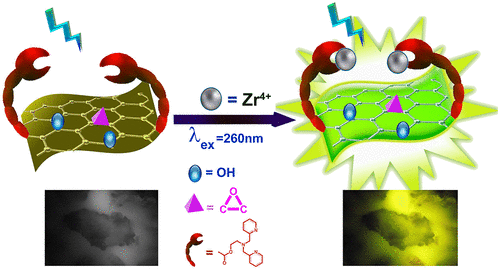当前位置:
X-MOL 学术
›
ACS Sustain. Chem. Eng.
›
论文详情
Our official English website, www.x-mol.net, welcomes your
feedback! (Note: you will need to create a separate account there.)
Covalently Modified Graphene Oxide as Highly Fluorescent and Sustainable Carbonaceous Chemosensor for Selective Detection of Zirconium ion in Complete Aqueous Medium
ACS Sustainable Chemistry & Engineering ( IF 7.1 ) Pub Date : 2020-09-15 , DOI: 10.1021/acssuschemeng.0c03282 Jeyaraj Belinda Asha 1 , Palaniswamy Suresh 1
ACS Sustainable Chemistry & Engineering ( IF 7.1 ) Pub Date : 2020-09-15 , DOI: 10.1021/acssuschemeng.0c03282 Jeyaraj Belinda Asha 1 , Palaniswamy Suresh 1
Affiliation

|
Zirconium, a medically important transition metal, found extensive application and was found to be relatively safe, however, continuous exposure will lead to adverse effects. Though zirconium is considered as a safe metal in biomaterials, no reliable sensing methodologies have been developed. In the present report, for the detection of medically influential zirconium(IV) ions, a graphene-based carbonaceous material has been developed. Covalent modification of graphene oxide (GO) with 2-bis(pyridine-2-ylmethyl)amino)ethan-1-ol (PAE) provides a new material GOP which is characterized using various analytical techniques such as elemental analysis, energy dispersive spectroscopy (EDS), FTIR, PXRD, Raman spectroscopy, X-ray photoelectron spectroscopy (XPS) and microscopic techniques SEM and HRTEM. All the analytical characterization techniques strongly supported the formation of covalently 2-bis(pyridine-2-ylmethyl)amino)ethan-1-ol tethered GO through an ester bond. Upon testing with a series of metal cations, intriguingly, an excellent photoluminescence response has been selectively originated from GOP with Zr(IV) in aqueous medium and it is utilized for the detection of Zr(IV). High selectivity toward Zr(IV) over the presence of other common coexisting metal ions was also demonstrated. Specific “turn-on” fluorescence response of GOP in the presence of Zr(IV) ion is rationalized via Fluorescence Resonance Energy Transfer (FRET) mechanism owing to the presence of ester bond as a spacer which brings PAE and GO closer. Further, the GOP is highly stable and sustainable, could recover and reuse for further sensor studies. The newly developed carbonaceous GOP material offers a new methodology for the detection of Zr(IV) in an aqueous medium with LOD of 27 ng/mL.
中文翻译:

共价修饰的氧化石墨烯作为高度荧光且可持续的碳质化学传感器,用于选择性检测完全水性介质中的锆离子
锆是医学上重要的过渡金属,已得到广泛应用,并且被发现相对安全,但是连续暴露会导致不利影响。尽管锆被认为是生物材料中的安全金属,但尚未开发出可靠的传感方法。在本报告中,为检测对医学有影响的锆(IV)离子,已开发出基于石墨烯的碳质材料。用2-双共价修饰氧化石墨烯(GO)(吡啶-2-基甲基)氨基)乙-1-醇(PAE)提供了一种新的材料GOP,其使用各种分析技术进行了表征,例如元素分析,能量色散光谱(EDS),FTIR,PXRD,拉曼光谱,X-射线光电子能谱(XPS)和显微技术SEM和HRTEM。所有的分析表征技术都强烈支持形成共价的2- bis(吡啶-2-基甲基)氨基)乙烷-1-醇通过酯键连接GO。有趣的是,经过一系列金属阳离子的测试,在水性介质中,具有Zr(IV)的GOP选择性地产生了出色的光致发光响应,并将其用于Zr(IV)的检测。还证明了在其他常见的共存金属离子存在下对Zr(IV)的高选择性。在Zr(IV)离子存在下,GOP的特定“开启”荧光响应通过荧光共振能量转移(FRET)机制得以合理化,这归因于酯键作为间隔基的存在,使PAE和GO更加紧密。此外,GOP具有高度的稳定性和可持续性,可以回收再利用以进行进一步的传感器研究。
更新日期:2020-09-28
中文翻译:

共价修饰的氧化石墨烯作为高度荧光且可持续的碳质化学传感器,用于选择性检测完全水性介质中的锆离子
锆是医学上重要的过渡金属,已得到广泛应用,并且被发现相对安全,但是连续暴露会导致不利影响。尽管锆被认为是生物材料中的安全金属,但尚未开发出可靠的传感方法。在本报告中,为检测对医学有影响的锆(IV)离子,已开发出基于石墨烯的碳质材料。用2-双共价修饰氧化石墨烯(GO)(吡啶-2-基甲基)氨基)乙-1-醇(PAE)提供了一种新的材料GOP,其使用各种分析技术进行了表征,例如元素分析,能量色散光谱(EDS),FTIR,PXRD,拉曼光谱,X-射线光电子能谱(XPS)和显微技术SEM和HRTEM。所有的分析表征技术都强烈支持形成共价的2- bis(吡啶-2-基甲基)氨基)乙烷-1-醇通过酯键连接GO。有趣的是,经过一系列金属阳离子的测试,在水性介质中,具有Zr(IV)的GOP选择性地产生了出色的光致发光响应,并将其用于Zr(IV)的检测。还证明了在其他常见的共存金属离子存在下对Zr(IV)的高选择性。在Zr(IV)离子存在下,GOP的特定“开启”荧光响应通过荧光共振能量转移(FRET)机制得以合理化,这归因于酯键作为间隔基的存在,使PAE和GO更加紧密。此外,GOP具有高度的稳定性和可持续性,可以回收再利用以进行进一步的传感器研究。











































 京公网安备 11010802027423号
京公网安备 11010802027423号